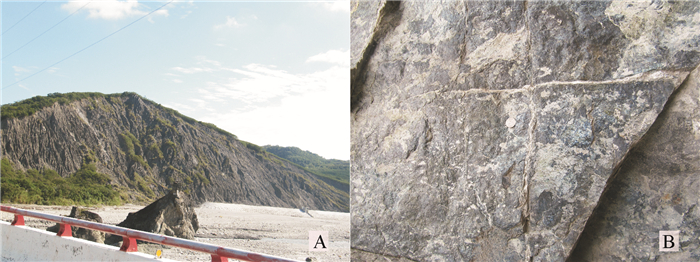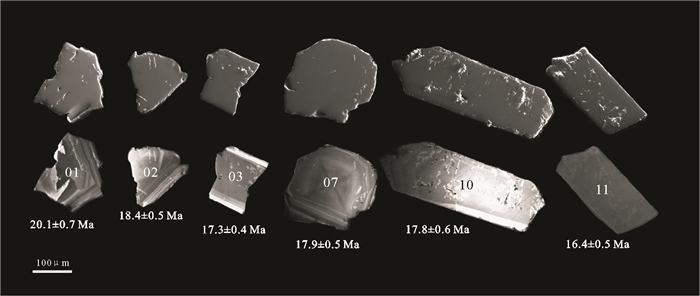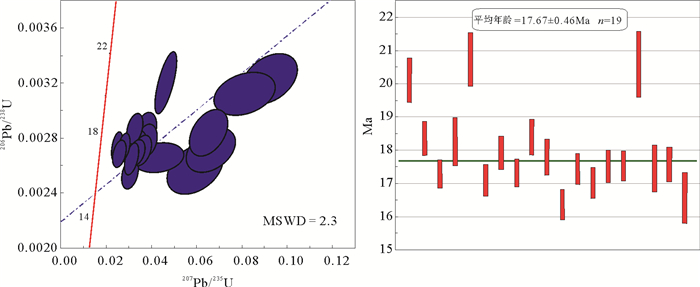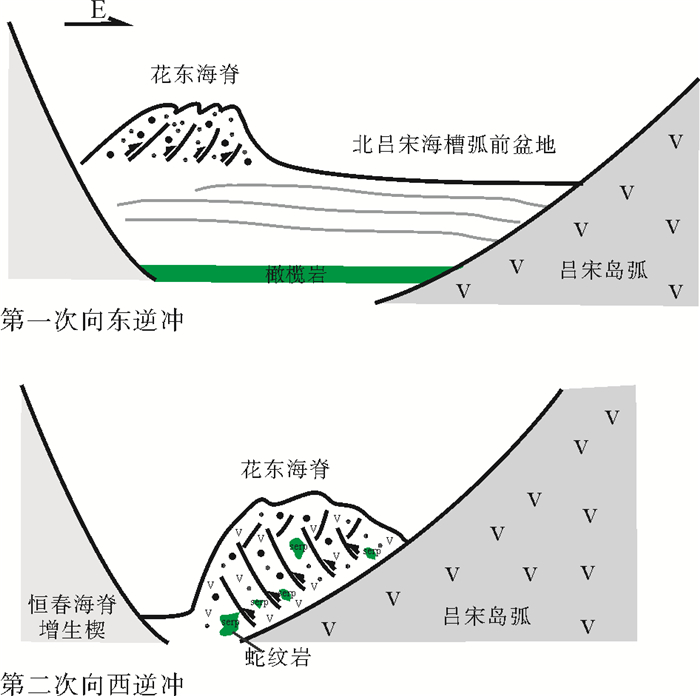Petrology and U-Pb geochronology of the serpentinite in the Lichi mélange of Eastern Taiwan and their tectonic implications
-
摘要:
台湾利吉混杂岩位于吕宋岛弧与欧亚大陆发生碰撞(弧陆碰撞)关键地带,是菲律宾海板块和欧亚板块结合带重点研究的区域,其中出露的蛇纹岩可以为研究弧陆碰撞造山过程提供重要细节信息。利吉混杂岩中蛇纹岩岩块原岩为橄榄岩,通过锆石U-Pb年代学分析,得到代表洋壳年龄的橄榄岩形成年龄为17.7±0.5Ma,结合南海洋壳、菲律宾海洋壳年龄和构造背景,判断利吉混杂岩中的蛇纹岩(蛇纹石化橄榄岩)来自马尼拉俯冲系统的弧前盆地,是在利吉混杂岩形成过程中经第二次逆冲混入利吉混杂岩系统的。明确蛇纹岩岩块来源可以为利吉混杂岩形成提供细节信息,为研究弧陆碰撞造山活动和板块运动提供可靠依据。
Abstract:Lichi Mélange, located along the plate suture between the southeastern Eurasian Plate and the Philippine Sea Plate, is a research focus of the collision of the Luzon Arc with the Eurasian Continent. The serpentinite, as a key component of the Mélange, can provide important information for studying the arc-continent collision. Petrographic study suggests that the protolith of the serpentinite is peridotite and the zircon U-Pb chronology data reveals that the serpentinite was formed 17.7±0.5 Ma. The serpentinite or serpentinised peridotite is supposed to come from a forearc basin in the Manila subduction system, based on their ages and the evolution of the South China Sea and the Philippine Sea as well as their tectonic backgrounds, and became part of the mélange in the second thrust westward. The origin of serpentinite in the Lichi Mélange may provide detailed information and a reliable basis for the study of arc-continent collision orogenic activity and plate tectonic movement.
-
Key words:
- the Lichi Mélange /
- serpentinite /
- arc-continent collision /
- U-Pb geochronology /
- Taiwan
-

-
表 1 利吉混杂岩中蛇纹岩样品CR-16锆石U-Pb测年结果
Table 1. U-Pb data for zircons from sample CR-16 in the Lichi Mélange
点 Th/10-6 U/10-6 Th/U 207Pb/235U 206Pb/238U rho 207Pb/235U 206Pb/238U 比值 1δ 比值 1δ 年龄/Ma 1δ 年龄/Ma 1δ 01 8713.87 2810.29 3.10 0.08143 0.00912 0.00313 0.00011 0.30 79.5 8.6 20.1 0.7 02 6466.59 2652.85 2.44 0.03275 0.00247 0.00285 0.00008 0.37 32.7 2.4 18.4 0.5 03 10575.96 3150.27 3.36 0.02600 0.00212 0.00268 0.00007 0.31 26.1 2.1 17.3 0.4 04 1591.10 1144.91 1.39 0.06552 0.00564 0.00284 0.00011 0.46 64.4 5.4 18.3 0.7 05 1359.32 1035.28 1.31 0.09187 0.00840 0.00323 0.00013 0.43 89.2 7.8 20.8 0.8 06 9256.35 2992.29 3.09 0.04407 0.00721 0.00266 0.00007 0.17 43.8 7.0 17.1 0.5 07 4670.87 2517.91 1.86 0.03789 0.00317 0.00278 0.00008 0.34 37.8 3.1 17.9 0.5 08 9487.53 3031.67 3.13 0.03393 0.00251 0.00269 0.00007 0.33 33.9 2.5 17.3 0.4 09 4713.09 2374.17 1.99 0.03777 0.00316 0.00286 0.00009 0.36 37.6 3.1 18.4 0.5 10 5198.71 2315.43 2.25 0.03536 0.00288 0.00276 0.00009 0.39 35.3 2.8 17.8 0.6 11 7263.84 2725.53 2.67 0.03079 0.00279 0.00254 0.00007 0.31 30.8 2.7 16.4 0.5 12 5054.18 2641.81 1.91 0.03590 0.00287 0.00271 0.00007 0.34 35.8 2.8 17.4 0.5 13 10001.42 3030.82 3.30 0.03132 0.00217 0.00264 0.00007 0.40 31.3 2.1 17.0 0.5 14 9479.40 2983.29 3.18 0.02505 0.00163 0.00272 0.00008 0.44 25.1 1.6 17.5 0.5 15 7965.91 2853.24 2.79 0.02792 0.00175 0.00272 0.00007 0.41 28.0 1.7 17.5 0.5 16 6253.29 2158.81 2.90 0.04646 0.00332 0.00320 0.00016 0.68 46.1 3.2 20.6 1.0 18 2548.62 1318.04 1.93 0.06640 0.00725 0.00271 0.00011 0.37 65.3 6.9 17.4 0.7 19 4872.20 2505.01 1.94 0.03388 0.00259 0.00273 0.00008 0.39 33.8 2.5 17.6 0.5 20 2341.44 1263.88 1.85 0.05901 0.00809 0.00257 0.00012 0.34 58.2 7.8 16.6 0.8 注:实验在中国地质大学(武汉)地质过程与矿产资源国家重点实验室(GPMR)利用LA-ICP-MS同时分析完成,对分析数据的离线处理(包括对样品和空白信号的选择、仪器灵敏度漂移校正、元素含量及U-Th-Pb同位素比值和年龄计算)采用软件ICPMSDataCal[29]完成,详细的仪器操作条件和数据处理方法同文献[29, 30]。 -
[1] Biq C C. Dual-trench structure in the Taiwan-Luzon region[J]. Proceedings of the Geological Society of China, 1972, 15: 65-75.
[2] Bowin C, Lu R S, Lee C S, et al. Plate convergence and accretion in Taiwan-Luzon region[J]. American Association of Petroleum Geologists Bulletin, 1978, 62(2): 1645-1672. https://www.onacademic.com/detail/journal_1000040489583410_0e9c.html
[3] Suppe J. Mechanics of mountain building and metamorphism in Taiwan[J]. Memoir of the Geological Society of China, 1981, 4: 67-89.
[4] Ho C S. A synthesis of the geological evolution of Taiwan[J]. Tectonophysics, 1986, 125(1-3): 1-16. doi: 10.1016/0040-1951(86)90004-1
[5] Teng L S. Geotectonic evolution of late Cenozoic arc-continental collision in Taiwan[J]. Tectonophysics, 1990, 183(1-4): 67-76. https://www.sciencedirect.com/science/article/pii/004019519090188E
[6] Chung S L, Sun S S. A new genetic model for the East Taiwan Ophiolite andits implications for dupal domains in the Northern hemi-sphere[J]. Earth Planet, 1992, 109(1-2): 133-145. doi: 10.1016/0012-821X(92)90079-B
[7] Chen C H, Yeh Y H. Bathymetric ridges and troughs in the active arc-continent collision region off southeastern Taiwan[J]. Proceedings of the Geological Society of China, 1990, 33(4): 351-372.
[8] Huang C Y, Shyu C T, Lin S B, et al. Marine geology in the arc-continent collision zone off southeastern Taiwan: Implications for late Neogene evolution of the Coastal Range[J]. Marine Geology, 1992, 107(3): 183-212. doi: 10.1016/0025-3227(92)90167-G
[9] Reed D L, Lundberg N, Liu C S, et al. Structural relations along the margins of the offshore Taiwan accretionary wedge: Implications for accretion and crustal kinematics[J]. Acta Geologica Taiwanica, 1992, 30: 105-122.
[10] Liu C S, Liu S Y, Lallemand S, et al. Digital elevation model offshore Taiwan and its tectonic implications[J]. Terrestrial, Atmospheric and Oceanic Sciences, 1998, 9(4): 705-738. doi: 10.3319/TAO.1998.9.4.705(TAICRUST)
[11] Malavieille J, Lallemand S E, Dominguez S, et al. Arc-continent collision in Taiwan: New marine observations and tectonic evolution[J]. Geological Society of America Bulletin, Special Paper, 2002, 358: 187-211. https://hal.archives-ouvertes.fr/hal-00406705
[12] Sibuet J C, Hsu S K. How was Taiwan created[J]. Tectonophysics, 2004, 379(1-4): 159-181. doi: 10.1016/j.tecto.2003.10.022
[13] 耿威, 张训华, 温珍河, 等.台湾东部海岸山脉对弧陆碰撞的响应[J].地质论评, 2013, 59(1): 129-136. doi: 10.3969/j.issn.0371-5736.2013.01.014
GENG Wei, ZHANG Xunhua, WEN Zhenhe, et al. A review on response of arc-continent collision in Coastal Range, eastern Taiwan[J]. Geological Review, 2013, 59(1): 129-136. doi: 10.3969/j.issn.0371-5736.2013.01.014
[14] 耿威, 张训华, 黄龙, 等.台湾及其附近海域区域地质特征与新构造运动[J].海洋地质与第四纪地质, 2014, 34(6): 73-82. http://www.wanfangdata.com.cn/details/detail.do?_type=perio&id=hydzydsjdz201406007
GENG Wei, ZHANG Xunhua, HUANG Long, et al. Regional geological features and neotectonic movement of inland and offshore of Taiwan[J]. Marine Geology & Quaternary Geology, 2014, 34(6): 73-82. http://www.wanfangdata.com.cn/details/detail.do?_type=perio&id=hydzydsjdz201406007
[15] Huang C Y. Bathymetric ridges and troughs in the active arc-continent col region off southeastern Taiwan: Reply and discussions[J]. Journal of the Geological Society of China, 1993, 36: 91-109. http://ntur.lib.ntu.edu.tw/handle/246246/206888#.XYGOW_kyZVA
[16] Chang C P, Angelier J, Huang C Y. origin and evolution of a Mélange: the active plate boundary and suture zone of the Longitudinal Valley, Taiwan[J]. Tectonophysics, 2000, 325(1-2): 43-62. doi: 10.1016/S0040-1951(00)00130-X
[17] Huang C Y, Yuan P B, Lin C W, et al. Geodynamic processes of Taiwan arc-continent collision and comparison with analogs in Timor, Papua New Guinea, Urals and Corsica[J]. Tectonophysics, 2000, 325(1-2): 1-21. doi: 10.1016/S0040-1951(00)00128-1
[18] Huang C Y, Jien C W, Chang C P, et al. The Lichi Mélange: a tectonic collision complex originated form sheared forearc in Coastal Range, eastern Taiwan[J]. Geological Society of America Bulletin, Special Paper, 2008, 436: 127-154.
[19] Mével C. Sepentinization of abyssal peridotites at mid-ocean ridges[J]. Comptes Rendus Geosciences, 2003, 335(10-11): 825-852. doi: 10.1016/j.crte.2003.08.006
[20] 汪小妹, 曾志刚, 欧阳荷根, 等.大洋橄榄岩的蛇纹岩石化研究进展评述[J].地球科学进展, 2010, 25(6): 605-616. http://www.wanfangdata.com.cn/details/detail.do?_type=perio&id=dqkxjz201006005
WANG Xiaomei, ZENG Zhigang, OUYANG Hegen, et al. Review of Progress in Serpentinization Research of Oceanic Peridotites[J]. Advances in Earth Science, 2010, 25(6): 605-616. http://www.wanfangdata.com.cn/details/detail.do?_type=perio&id=dqkxjz201006005
[21] 陈正宏.台湾之火成岩[M].台北:经济中央地质调查所, 1990: 28-31.
CHEN Chenghong. Igneous Rocks in Taiwan[M]. Taipei: Central Geological Survey, 1990: 28-31.
[22] Chang L S. A biostratigraphic study of the Tertiary in the Coastal Range, eastern Taiwan, based on smaller foraminifera (I. Southern Part)[J]. Proceedings of the Geological Society of China, 1967, 10: 64-76. http://dx.doi.org/10.1038/npre.2009.2947
[23] 纪文荣, 蓝生杰, Suppe J.台湾东部海岸山脉板块互撞之地层记录[J].中国地质学会专刊, 1981, 4: 155-194.
CHI Wenrong, LAN Shengjie, Suppe J. Stratigraphic record of plate interactions in the Coastal Range of eastern Taiwan[J]. Proceedings of the Geological Society of China, 1981, 4: 155-194.
[24] 纪文荣.台湾利吉层与垦丁层内之超微化石及其在地层构造上之意义[J].地质, 1982, 4(1): 99-114.
CHI Wenrong. The calcareous nannofossils of the Lichi Mélange and the Kenting Mélange and their significance in the interpretation of plate-tectonics of the Taiwan region[J]. Geology, 4(1): 99-114.
[25] Barrier E, Muller C. New observations and discussion on the origin and age of the Lichi Mélange[J]. Memoir of the Geological Society of China, 1984, 6: 303-325.
[26] Huang T Y. Some planktonic foraminifera from abore at Shihshan, near Taitung, eastern Taiwan[J]. Proceedings of the Geological Society of China, 1969, 12: 63-72.
[27] Huang C Y, Yuan P B, Song S R, et al. Tectonic of short-lived intra-arc basins in the arc-continent collision terrane of the Coastal Range, eastern Taiwan[J]. Tectonics, 1995, 14(1): 19-38. doi: 10.1029/94TC02452
[28] 吴元保, 郑永飞.锆石成因矿物学研究及其对U-Pb年龄解释的制约[J].科学通报, 2004, 49(16): 1589-1604. http://www.wanfangdata.com.cn/details/detail.do?_type=perio&id=kxtb200416002
WU Yuanbao, ZHENG Yongfei. Genesis of zircon and its constraints on interpretation of U-Pb age[J]. Chinese Science Bulletin, 2004, 49(15): 1554-1569. http://www.wanfangdata.com.cn/details/detail.do?_type=perio&id=kxtb200416002
[29] Liu Y S, Gao S, Hu Z C, et al. Continental and oceanic crust recycling-induced melt-peridotite interactions in the Trans-North China Orogen: U-Pb dating, Hf isotopes and trace elements in zircons from mantle xenoliths[J]. Journal of Petrology, 2010, 51(1-2): 537-571. doi: 10.1093/petrology/egp082
[30] Liu Y S, Hu Z C, Zong K Q, et al. Reappraisement and refinement of zircon U-Pb isotope and trace element analyses by LA-ICP-MS[J]. Chinese Science Bulletin, 2010, 55(15): 1535-1546. doi: 10.1007/s11434-010-3052-4
[31] Huang T C, Ting J S. Calcareous nannofossils succession from the Oligo-Miocene Peikangchi section and revised stratigraphic correlation between northern and central Taiwan[J]. Proceedings of the Geological Society of China, 1979, 22: 105-120.
[32] Taylor B, Hayes D E. Origin and history of the South China Sea Basin[C]//Hayes D E, ed. The Tectonic and Geologic Evolution of Southeast Asian Seas and Islands Part Ⅱ. Washington: AGU, 1983, 20: 129-155.
[33] Chu H T, Shen P Y, Jeng R C. The origin of chromitite from the Kenting Mélange, southern Taiwan[J]. Proceedings of the Geological Society of China, 1988, 31: 33-52.
[34] Huang C Y, Wu WY, Chang C P, et al. Tectonic evolution of accretionary prism in the arc-continent collision terrane of Taiwan[J]. Tectonophysics, 1997, 281(1-2): 31-51. doi: 10.1016/S0040-1951(97)00157-1
[35] Juan V C, Lo H J, Chen C C. Genetic relationships and emplacement of the exotic basic rocks enclosed in the Lichi Mélange, eastern Coastal Range, Taiwan[J]. Proceedings of the Geological Society of China, 1992, 23: 56-68.
[36] Deschamps A, Lallemand S. The west philippine sea basin: an Eocene to early Oligocene back arc basin opened between two opposed subduction zones[J]. Journal of Geophysical Research, 2002, 107(B12): EPM 1-1-EPM 1-24. doi: 10.1029/2001JB001706
[37] Yeh K Y, Cheng Y N. The first finding of early Cretaceous radiolarians from Lanyu, the Philippine Sea Plate[J]. Bulletin of National Science Museum, 2001, 13: 113-145.
[38] Fryer P, Ambos E L, Hussong D M. Origin and emplacement of Mariana forearc seamounts[J]. Geology, 1985, 13(11): 774-777. doi: 10.1130/0091-7613(1985)13<774:OAEOMF>2.0.CO;2
[39] Maekawa H, Yamamoto K, Ishii T, et al. Serpentinite seamounts and hydrated mantle wedge in the Izu-Bonin and Mariana forearc regions[J]. Bulletin of the Earthquake Research Institute, University of Tokyo, 2001, 76(3): 355-366.
[40] Guollot S, Hattori K H, De Sigoyer J. Mantle wedge serpentinization and exhumation of eclogites: insights from eastern Ladakh, northwest Himalaya[J]. Geology, 2000, 28(3): 199-202. doi: 10.1130/0091-7613(2000)28<199:MWSAEO>2.0.CO;2
[41] Rizeli M E, Beyarslan M, Wang K L, et al. Mineral chemistry and petrology of mantle peridotites from the Guleman ophiolite (SE Anatolia, Turkey): Evidence of a forearc setting[J]. Journal of African Earth Sciences, 2016, 123: 392-402. doi: 10.1016/j.jafrearsci.2016.08.013
[42] Abdel-Karim A M, Ali S, Helmy H M, et al. A fore-arc setting of the Gerf ophiolite, Eastern Desert, Egypt: Evidence from mineral chemistry and geochemistry of ultramafites[J]. Lithos, 2016, 263: 52-65. doi: 10.1016/j.lithos.2016.05.023
[43] Nozaka T. Metasomatic hydration of the Oeyama forearc peridotites: Tectonic implications[J]. Lithos, 2014, 184-187: 346-360. http://adsabs.harvard.edu/abs/2014Litho.184..346N
-




 下载:
下载:




